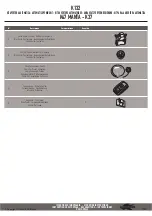
TIPS AND WARNINGS WHEN STARTING THE MOTORCYCLE
Information on initial start-up
– Make sure your authorized KTM dealer has provided the
services required to make your vehicle "READY TO DRIVE"
(see service manual).
– Read the entire Owner's Manual carefully before you take
your first ride.
– Enter the chassis, engine and key numbers on page 1.
– Familiarize yourself with the control elements.
– Set the hand brake lever and the foot brake pedal in the
most suitable position for you.
– Practice handling the motorcycle on an empty parking lot or
on easy terrain before starting out on a longer ride. Try dri-
ving as slowly as possible and standing up to get a better
feel for the motorcycle.
– Do not take the bike off-road until you have enough
experience.
– Hold on to the handlebar with both hands while driving and
leave your feet on the footrests.
– Take your foot off the brake lever whenever you are not
braking. Leaving your foot on the foot brake pedal will
cause the brake pads to drag and the brake to overheat.
– Do not modify the motorcycle and always use "Original
KTM spare parts". Spare parts from other manufacturers
can impair the safety of your motorcycle.
– Observe the breaking-in instructions.
Breaking-in
The finely machined surfaces of new engine parts have a roug-
her surface than parts that have been in use for longer periods
of time. Every engine needs to be broken-in and should not be
taken to its performance limit during the first 1000 kilometers.
You should not exceed an engine speed of 4800 rpm. Drive
the motorcycle under different operating conditions for the
first 1000 kilometers (road, easy terrain). The following table
shows the maximum speed in the individual gears at 4800
rpm, based on the rear wheel transmission.
NOTE: use mineral oil-based engine oil during the breaking-in
period, i.e. during the first 1000 kilometers. This also applies if
the engine was repaired.
WARNING
– D
RESS PROPERLY FOR THE RIDE
. S
MART
KTM
DRIVERS ALWAYS WEAR
A HELMET
,
BOOTS
,
GLOVES AND A JACKET
,
WHETHER TAKING A DAY
TRIP OR JUST A SHORT RIDE
. P
ROTECTIVE CLOTHING SHOULD BE
CONSPICUOUS TO MAKE SURE OTHER ROAD USERS SEE YOU IN TIME
.
P
ASSENGERS SHOULD ALSO WEAR SUITABLE PROTECTIVE CLOTHING
.
– D
O NOT DRIVE AFTER DRINKING ALCOHOL
.
– A
LWAYS SWITCH ON THE LIGHT WHILE DRIVING TO MAKE SURE OTHER
ROAD USERS SEE YOU IN TIME
.
– O
NLY USE ACCESSORIES APPROVED BY
KTM. F
RONT FAIRING
,
FOR
EXAMPLE
,
CAN HAVE AN ADVERSE EFFECT ON THE MOTORCYCLE
'
S
DRIVING BEHAVIOR AT HIGH SPEEDS
. T
HE DIFFERENT WEIGHT DISTRIBU
-
TION CAUSED BY TRUNKS
,
SPARE TANKS
,
ETC
.
CAN ALSO HAVE AN
ADVERSE EFFECT ON DRIVING BEHAVIOR
.
– A
LWAYS USE FRONT AND REAR TIRES WITH THE SAME TREAD PATTERN
.
– N
EW TIRES HAVE A SMOOTH SURFACE AND WILL NOT HAVE FULL
ADHESION
. T
HE ENTIRE TIRE TREAD NEEDS TO BE GROUND DURING THE
FIRST
200
KILOMETERS OF CONSTANT DRIVING IN ALTERNATING
BANKING POSITIONS
. F
ULL TIRE ADHESION WILL BE ACHIEVED WHEN
THE BIKE IS BROKEN IN
.
– D
RIVE THE FIRST FEW KILOMETERS OF EACH TRIP AT A MODERATE
SPEED TO ALLOW THE TIRES TO OBTAIN RUNNING TEMPERATURE
.
M
AXIMUM ADHESION CANNOT BE GUARANTEED UNTIL THE TIRES HAVE
RUNNING TEMPERATURE
.
– O
BSERVE THE TRAFFIC REGULATIONS
,
DRIVE DEFENSIVELY AND LOOK
AHEAD TO DETECT POTENTIAL HAZARDS AS EARLY AS POSSIBLE
.
– A
DAPT YOUR DRIVING SPEED TO THE CONDITIONS AND YOUR DRIVING
SKILL
.
– B
E CAREFUL WHEN DRIVING ON UNFAMILIAR ROADS OR TERRAIN
.
– R
EPLACE THE HELMET VISOR OR THE LENSES IN YOUR GLASSES IN TIME
TO GUARANTEE MAXIMUM VISION IN ANY SITUATION
. A
SCRATCHED
VISOR OR SCRATCHED LENSES CAN MAKE YOU PRACTICALLY BLIND IN
BACK LIGHT
.
– N
EVER LEAVE YOUR MOTORCYCLE UNATTENDED WITH THE ENGINE
RUNNING
.
Accessories and payload
Motorcycles are sensitive to changes in the weight distribution.
If you are taking baggage, fasten it close to the center of the
motorcycle and distribute the weight evenly on the front and
rear wheels. Do not exceed the maximum gross weight or the
wheel loads. The maximum gross weight is comprised of:
– the ready to drive, refueled motorcycle
– baggage
– driver with protective clothing and helmet.
Accessory parts and baggage can significantly reduce the
motorcycle's driving stability. Please heed the following
warnings.
WARNING
– N
EVER DRIVE FASTER THAN
130
KPH IF ACCESSORY PARTS ARE
MOUNTED ON YOUR MOTORCYCLE
. A
CCESSORY PARTS CAN SIGNIFI
-
CANTLY IMPAIR THE MOTORCYCLE
'
S HANDLING
,
ESPECIALLY IN THE
MAXIMUM SPEED RANGE
.
– N
EVER DRIVE FASTER THAN
130
KPH IF YOUR MOTORCYCLE IS LOADED
WITH CASES OR OTHER BAGGAGE
. T
HEY WILL IMPAIR THE MOTORCY
-
CLE
'
S HANDLING AT HIGHER SPEEDS AND CAN EASILY CAUSE IT TO GO
OUT OF CONTROL
.
– I
F CASES ARE MOUNTED
,
DO NOT EXCEED THE MANUFACTURER
'
S
RECOMMENDED MAXIMUM PAYLOAD
.
– F
ASTEN THE BAGGAGE CLOSE TO THE CENTER OF THE MOTORCYCLE
AND DISTRIBUTE THE WEIGHT EVENLY ON THE FRONT AND REAR
WHEELS AND ON THE LEFT AND RIGHT
.
– B
AGGAGE MUST BE SECURELY AND ADEQUATELY FASTENED
;
LOOSE
BAGGAGE WILL SIGNIFICANTLY IMPAIR DRIVING SAFETY
.
– A
HIGH PAYLOAD WILL CHANGE THE MOTORCYCLE
'
S HANDLING AND
CONSIDERABLY
INCREASE
THE
BRAKING
DISTANCE
;
ADAPT
YOUR
DRIVING SPEED ACCORDINGLY
.
– I
F THE PAYLOAD IS INCREASED
,
THE HEADLIGHT LAMP AND PRELOAD
ADJUSTER MUST BE ADAPTED ACCORDINGLY
.
16:50 Z
1st gear
30 KPH
2nd gear
45 KPH
3rd gear
60 KPH
4th gear
75 KPH
5th gear
85 KPH
Gear
Transmission
11













































